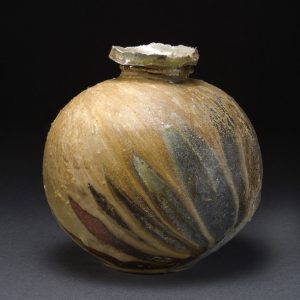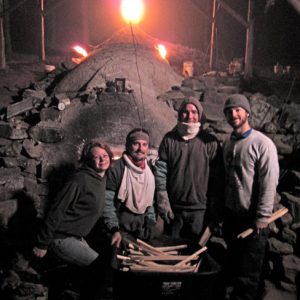calsfoundation@cals.org
Joseph Aloysius Bruhin (1953–)
Ceramic artist Joseph Aloysius Bruhin III of Fox (Stone County) was awarded the Arkansas Arts Council Fellowship in 1992 and has been the recipient and winner of numerous “best of show” awards. Nationally, Bruhin figures among two dozen potters who are recognized as specializing in wood-fired pottery. He is the first contemporary potter to work continuously with a wood-fired kiln in Arkansas.
Joe Bruhin was born on April 7, 1953, in St. Louis, Missouri, to Virginia Bruhin and Joseph Aloysius Bruhin Jr., an electrician; he was one of four boys. At age fifteen, Bruhin was hitchhiking and backpacking to the western states of Colorado, California, and Washington. He graduated from high school in 1971 and spent some time exploring Florida and the East Coast.
In 1973, he married Terri Sommer, and they had one son. In 1974, Bruhin enlisted in the U.S. Army so that he and his wife could live in Europe. He arranged to have his discharge in Europe so that he and his wife and son could travel. For nine months, the family traveled in a Volkswagen bus throughout Europe, North Africa, India, and as far east as Nepal before returning to St. Louis.
Upon returning to the United States in 1978, Bruhin enrolled at St. Louis Community College at Meramec, where he studied with ceramist Bob Allen. After two years, he transferred to Maryville University in St. Louis, where he studied with ceramist Jeri Au. During this time period, he helped support himself by working as a park caretaker. In 1981–1982, the GI Bill enabled Bruhin to do independent study of ceramics through Idaho State University in Pocatello, with a residency at Sun Valley Center for the Arts and Humanities in Idaho. Sun Valley had a program of visiting artists and a good kiln yard, where Bruhin gained experience building and firing wood-burning kilns. At this point, Bruhin fell under the influence of Shoji Hamada, a Japanese potter who introduced the concept of mingei (Japanese folk art) to American potters.
Completing his studies, Bruhin returned to St. Louis, determined to set up his own pottery. He and his wife acquired forty acres of land in Arkansas outside of Fox in 1983, and from 1986 to 1989, the family lived some of the time in a tepee while building an 800-square-foot studio and living quarters; sheds and storage buildings; and Bruhin’s three-chamber, climbing, cross-draft, wood-burning Noborigama-type kiln. The kiln was named Falstaff because the bricks for it were salvaged from the old Falstaff Brewery in St. Louis. Between finishing his studies in 1983 and beginning his first work cycle in 1989, Bruhin did not create any pottery. Later, in 1993, with a fellowship from the Arkansas Arts Council, Bruhin built a studio independent of the living quarters. In 2004, Bruhin built an Anagama kiln modeled after the kiln of Shiho Kanzaki, a potter from Shigaraki whom Bruhin spent time with in the winter of 2003.
Bruhin typifies the craftsman revival in Arkansas and its connection to the back-to-the-land movement that occurred in the state after the Korean War in the 1950s. Bruhin’s aesthetic leanings are toward classical Chinese and Korean traditions, as well as the Japanese traditions of Bizen, Iga, and Shigaraki ceramics. These Japanese styles feature rough texture, asymmetry, simplicity, naturalness, spontaneity, and calmness—favorable traits for the tea ceremony. The style was adopted by American potters who were influenced by Japanese ceramics and the Abstract Expressionist movement, which rebelled against the precision, symmetry, and coldness of European styles. Bruhin’s forms encompass a broad range from tea bowls, bowls, plates, bottles, and pitchers to large jars and platters intended as decorative elements for the wall.
Bruhin was recognized for his work in several exhibitions at the Arkansas Arts Center (now the Arkansas Museum of Fine Arts) in Little Rock (Pulaski County). The first was Arkansas: Year of American Craft, 1993, at which Bruhin was recognized by the curator of the Arts Center as being one of the top twenty-five craft artists working in the state. Bruhin was also recognized in another exhibition at the Arts Center, Born of Ashes: Wood Fired Ceramics, a national invitational exhibition consisting of twenty-five top wood-firing potters working in the country at the time.
For additional information:
Bruhin, Terri. “Reflections on Wood Firing.” Ceramics Monthly, September 1994, pp. 66–71.
Du Bois, Alan. Arkansas: Year of American Craft, 1993. Exhibition catalogue. Little Rock: Arkansas Arts Center, 1993.
———. “Born of Ashes: Woodfired Ceramics.” Exhibition catalogue. Little Rock: Arkansas Arts Center, Decorative Arts Museum, 1999.
Joe Bruhin. Off the Beaten Path Studio Tour. http://www.offthebeatenpathstudiotour.com/joe-bruhin/ (accessed February 8, 2022).
Alan Du Bois
Benton, Arkansas
 Arts, Culture, and Entertainment
Arts, Culture, and Entertainment Anagama Fired Jar
Anagama Fired Jar  Joe Bruhin and Crew
Joe Bruhin and Crew  Iga Tea Bowl
Iga Tea Bowl  Iga Vase
Iga Vase 




Comments
No comments on this entry yet.